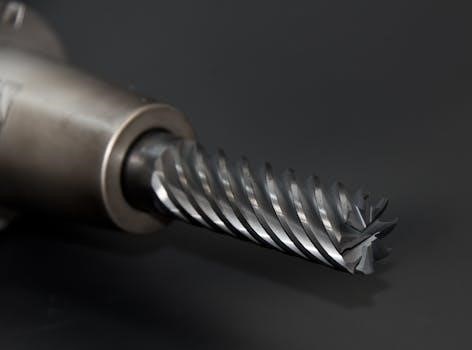Portable drill guides are essential tools for enhancing drilling precision and stability․ These devices assist in creating accurate holes‚ preventing wobbling‚ and ensuring clean drilling results․ They are ideal for DIYers and professionals alike․
What are Portable Drill Guides?
Portable drill guides are jigs designed to improve the accuracy of handheld drills․ They provide stability‚ ensuring the drill moves straight into the material without wobbling․ These guides often feature a chuck to attach the drill and guide the bit․ They are used to achieve precise angled or straight holes․ Some models feature adjustable angle settings for various project needs․ Portable drill guides come in various designs‚ including pressing mechanisms and blocks‚ to suit different drilling tasks․
Types of Portable Drill Guides
Portable drill guides are generally categorized into two main types⁚ those that use a pressing mechanism and drill guide blocks․ These designs cater to different drilling needs and preferences․
Pressing Mechanism Guides
Pressing mechanism guides feature a chuck where a power drill is attached‚ accommodating specific drill bit sizes․ These guides often incorporate angle adjustment capabilities‚ allowing for controlled boring up to 45 degrees and more․ They provide stability and precision‚ making them suitable for various drilling tasks․ Some models may also include depth control mechanisms to prevent over-drilling and material damage․ These guides are ideal for projects requiring accurate and consistent hole placement․
Drill Guide Blocks
Drill guide blocks are portable tools designed with holes for multiple drill sizes and do not directly attach to the drill itself․ These blocks are easy to carry around‚ making them suitable for various job sites and are often more compact․ However‚ they might be less accurate than pressing mechanism guides and require additional effort to secure in place․ They are a simple solution for basic drilling needs where ultimate precision is less crucial․

Key Features of Portable Drill Guides
Key features include material durability‚ often using metal for sturdiness‚ and angle adjustment capabilities for versatile drilling․ These aspects ensure the tool’s reliability and precision during use․
Material Durability
The durability of a portable drill guide is paramount‚ and is often determined by the materials used in its construction․ Metal-based guides‚ like those made from heat-treated steel or aluminum alloy‚ tend to be more robust and resistant to wear and tear than plastic alternatives․ This ensures they can withstand regular use and provide consistent performance over time‚ resisting corrosion and maintaining structural integrity․ A durable guide is a worthwhile investment․
Angle Adjustment Capabilities
Angle adjustment is a crucial feature in portable drill guides‚ enabling users to drill holes at various angles‚ typically ranging from 0 to 60 degrees or even 90 degrees․ This capability provides flexibility for diverse projects‚ such as creating angled joints or installing hardware․ A drill guide with an easy-to-read protractor scale and secure locking mechanisms ensures precision and repeatability when adjusting to different angles‚ making it an essential asset for any workshop․

Benefits of Using Portable Drill Guides
Portable drill guides offer improved drilling accuracy‚ enhanced speed‚ and increased stability․ These tools prevent material waste by ensuring precise‚ consistent holes‚ making projects more efficient and professional․
Improved Drilling Accuracy
Portable drill guides significantly enhance drilling accuracy by providing a stable platform and guiding the drill bit precisely․ They prevent wobbling and ensure that holes are drilled straight and at the correct angle‚ reducing errors․ This precision leads to cleaner‚ more professional-looking results and minimizes the risk of damaging materials․ Using a drill guide helps to achieve consistent hole placement and depth‚ which is particularly crucial for detailed projects․
Enhanced Drilling Speed
Portable drill guides contribute to enhanced drilling speed by streamlining the process․ They eliminate the need for repetitive measurements and adjustments‚ allowing users to focus solely on drilling․ The added stability and control offered by these guides enable faster and more efficient drilling‚ reducing the overall time spent on projects․ Furthermore‚ with consistent drilling‚ mistakes are minimized‚ which also prevents time-consuming re-work and further increasing the speed of the task․
Stability and Control
Portable drill guides greatly improve stability and control during drilling tasks․ By firmly holding the drill at a set angle‚ these guides prevent wobbling and ensure that the drill bit moves straight into the material․ This enhanced stability not only contributes to more precise holes but also allows for better management of the drilling process․ The increased control also minimizes the risk of slippage and potential damage to the workpiece or the user․
Compatibility with Drills
Portable drill guides are generally compatible with various drill models‚ but it is crucial to check size specifications․ Some guides work with specific chuck sizes like 3/8″ or 1/2″․
Drill Size Compatibility
When choosing a portable drill guide‚ it’s essential to verify its compatibility with your drill’s size․ Many guides are designed to accommodate standard drill chuck sizes‚ such as 3/8-inch or 1/2-inch․ Some models offer versatility with multiple drill size options‚ often ranging from 1/16 inch to 1/2 inch․ Always confirm the drill guide’s specifications to ensure it fits your specific drill‚ preventing any compatibility issues during use․
Specific Portable Drill Guide Models
Several models stand out in the market‚ including the Milescraft DrillMate and Big Gator Drill Guides․ These models are known for their durability‚ accuracy‚ and compatibility with various drill sizes․
Milescraft DrillMate
The Milescraft DrillMate is a popular portable drill guide designed for DIY enthusiasts and weekend project takers․ It enhances drilling accuracy with its adjustable angle settings at 45‚ 60‚ 75‚ and 90 degrees․ It attaches to standard 3/8-inch and 1/2-inch drills․ A spring attachment and adjuster control drilling depth‚ preventing unnecessary damage to materials․ This lightweight tool is easy to store and transport‚ making it a versatile option for various projects․
Big Gator Drill Guides
Big Gator drill guides are known for their durability and compatibility․ They are constructed from heat-treated steel‚ coated with light oil to prevent rust‚ ensuring long-lasting performance․ This guide is compatible with 17 different drill sizes ranging from 1/8 inch to 3/8 inch‚ making it suitable for various materials such as plastic‚ wood‚ and metal․ The product comes with a lifetime warranty‚ reflecting its robust construction and reliability for consistent‚ accurate drilling․
Additional Features to Consider
When selecting a drill guide‚ look for features like depth stop mechanisms for consistent drilling depths․ Self-centering features also improve accuracy‚ especially on round materials‚ making the drilling process much easier․
Depth Stop Mechanisms
Depth stop mechanisms are crucial for consistent drilling‚ preventing over-drilling and material damage․ These mechanisms allow users to set a specific drilling depth‚ ensuring that holes are uniform and precise․ The feature is particularly useful in woodworking and other projects where consistent hole depth is crucial․ These mechanisms are usually easy to adjust with a simple knob or a screw‚ and many of the portable drill guides come with this feature‚ which enhances the overall functionality and precision of the tool․
Self-Centering Features
Self-centering features are invaluable for drilling precise holes‚ especially in round materials like dowels or pipes․ These features ensure the drill bit starts at the exact center‚ eliminating the risk of off-center holes․ Self-centering pins or V-guides are often incorporated into portable drill guides to achieve this functionality‚ providing stability and accuracy during drilling․ This feature is exceptionally useful when working with cylindrical objects where precise central drilling is essential‚ enhancing the overall quality of the project․

How to Use a Portable Drill Guide
Using a portable drill guide involves securely attaching your drill‚ selecting the correct drill bit‚ and setting the desired drilling angle․ This ensures precise and controlled drilling operations for various projects․
Attaching a Drill
To attach a drill to a portable drill guide‚ first ensure the drill is compatible with the guide’s chuck size‚ typically 3/8 inches or 1/2 inches; Securely insert the drill into the guide’s chuck‚ tightening it with the included key․ Make sure the drill is firmly held to prevent slippage during operation․ A firm connection is crucial for accurate drilling results and user safety‚ ensuring stability throughout the process․
Setting the Drilling Angle
Setting the drilling angle on a portable drill guide usually involves adjusting the guide’s angle mechanism․ Many guides have a protractor scale to mark angles‚ often ranging from 0 to 60 or 90 degrees․ Loosen the locking mechanism‚ adjust the guide to the desired angle‚ and then secure it tightly․ Accurate angle settings are crucial for various applications‚ providing versatility in different woodworking and metalworking projects․ Ensure the angle is fixed before starting drilling․

Advantages for DIY Projects
Portable drill guides are ideal for DIY projects‚ offering enhanced accuracy and speed․ They provide stability and control‚ ensuring precise drilling for woodworking and metal projects‚ reducing errors and material waste․
Suitable for Woodworking
Portable drill guides are exceptionally beneficial for woodworking projects‚ providing the accuracy needed for precise joinery and hardware installation․ They eliminate the hassle of repeated measurements‚ ensuring that holes are drilled straight and at the correct angles․ This is crucial for assembling furniture‚ building cabinets‚ and other woodworking tasks where precision is paramount․ The use of a drill guide also reduces the risk of damaging the wood and improves the overall quality of the finished piece․ These guides can also aid in drilling pocket holes․
Ideal for Metal Drilling
Portable drill guides are also highly effective for metal drilling‚ providing stability and accuracy when working with harder materials․ They help to prevent the drill bit from wandering‚ which is especially important when drilling into metal surfaces․ The guides ensure that holes are drilled at the correct angles and depths‚ reducing the risk of damage or breakage․ They are beneficial for tasks such as creating mounting holes or joining metal components with precision․ The use of a drill guide also improves drilling speed and efficiency when working with metal․
Choosing the right drill guide involves considering factors like material‚ compatibility‚ and desired features․ A suitable guide enhances drilling accuracy‚ speed‚ and overall project success for both DIY and professional applications;
Choosing the Right Drill Guide
Selecting the ideal portable drill guide requires careful consideration of several factors․ Accuracy is paramount‚ ensuring the guide delivers precise measurements and angles․ Material durability is also key‚ with metal-based guides often proving more robust than plastic․ Compatibility with your drill’s size and type is essential․ Consider models with adjustable angles‚ depth stops‚ and self-centering features․ User reviews and research can help identify a drill guide that meets your specific needs and project requirements․
